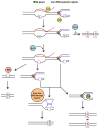APOBEC3B cytidine deaminase targets the non-transcribed strand of tRNA genes in yeast
- PMID: 28351647
- PMCID: PMC5450012
- DOI: 10.1016/j.dnarep.2017.03.003
APOBEC3B cytidine deaminase targets the non-transcribed strand of tRNA genes in yeast
Erratum in
-
Corrigendum to "APOBEC3B cytidine deaminase targets the non-transcribed strand of tRNA genes in yeast" [DNA Repair 53 (2017) 4-14].DNA Repair (Amst). 2019 Aug;80:94-95. doi: 10.1016/j.dnarep.2019.05.006. Epub 2019 Jun 7. DNA Repair (Amst). 2019. PMID: 31182349 No abstract available.
Abstract
Variations in mutation rates across the genome have been demonstrated both in model organisms and in cancers. This phenomenon is largely driven by the damage specificity of diverse mutagens and the differences in DNA repair efficiency in given genomic contexts. Here, we demonstrate that the single-strand DNA-specific cytidine deaminase APOBEC3B (A3B) damages tRNA genes at a 1000-fold higher efficiency than other non-tRNA genomic regions in budding yeast. We found that A3B-induced lesions in tRNA genes were predominantly located on the non-transcribed strand, while no transcriptional strand bias was observed in protein coding genes. Furthermore, tRNA gene mutations were exacerbated in cells where RNaseH expression was completely abolished (Δrnh1Δrnh35). These data suggest a transcription-dependent mechanism for A3B-induced tRNA gene hypermutation. Interestingly, in strains proficient in DNA repair, only 1% of the abasic sites formed upon excision of A3B-deaminated cytosines were not repaired leading to mutations in tRNA genes, while 18% of these lesions failed to be repaired in the remainder of the genome. A3B-induced mutagenesis in tRNA genes was found to be efficiently suppressed by the redundant activities of both base excision repair (BER) and the error-free DNA damage bypass pathway. On the other hand, deficiencies in BER did not have a profound effect on A3B-induced mutations in CAN1, the reporter for protein coding genes. We hypothesize that differences in the mechanisms underlying ssDNA formation at tRNA genes and other genomic loci are the key determinants of the choice of the repair pathways and consequently the efficiency of DNA damage repair in these regions. Overall, our results indicate that tRNA genes are highly susceptible to ssDNA-specific DNA damaging agents. However, increased DNA repair efficacy in tRNA genes can prevent their hypermutation and maintain both genome and proteome homeostasis.
Published by Elsevier B.V.
Figures




Similar articles
-
APOBEC3A and APOBEC3B Preferentially Deaminate the Lagging Strand Template during DNA Replication.Cell Rep. 2016 Feb 16;14(6):1273-1282. doi: 10.1016/j.celrep.2016.01.021. Epub 2016 Jan 28. Cell Rep. 2016. PMID: 26832400 Free PMC article.
-
Genetic inhibitors of APOBEC3B-induced mutagenesis.Genome Res. 2023 Sep;33(9):1568-1581. doi: 10.1101/gr.277430.122. Epub 2023 Aug 2. Genome Res. 2023. PMID: 37532520 Free PMC article.
-
Observation by Real-Time NMR and Interpretation of Length- and Location-Dependent Deamination Activity of APOBEC3B.ACS Chem Biol. 2017 Nov 17;12(11):2704-2708. doi: 10.1021/acschembio.7b00662. Epub 2017 Oct 3. ACS Chem Biol. 2017. PMID: 28952713
-
Mutating for Good: DNA Damage Responses During Somatic Hypermutation.Front Immunol. 2019 Mar 12;10:438. doi: 10.3389/fimmu.2019.00438. eCollection 2019. Front Immunol. 2019. PMID: 30915081 Free PMC article. Review.
-
APOBEC3B: pathological consequences of an innate immune DNA mutator.Biomed J. 2015 Mar-Apr;38(2):102-10. doi: 10.4103/2319-4170.148904. Biomed J. 2015. PMID: 25566802 Review.
Cited by
-
Single-stranded DNA binding proteins influence APOBEC3A substrate preference.Sci Rep. 2021 Oct 25;11(1):21008. doi: 10.1038/s41598-021-00435-y. Sci Rep. 2021. PMID: 34697369 Free PMC article.
-
Glycidamide-induced hypermutation in yeast single-stranded DNA reveals a ubiquitous clock-like mutational motif in humans.Nucleic Acids Res. 2023 Sep 22;51(17):9075-9100. doi: 10.1093/nar/gkad611. Nucleic Acids Res. 2023. PMID: 37471042 Free PMC article.
-
High density of unrepaired genomic ribonucleotides leads to Topoisomerase 1-mediated severe growth defects in absence of ribonucleotide reductase.Nucleic Acids Res. 2020 May 7;48(8):4274-4297. doi: 10.1093/nar/gkaa103. Nucleic Acids Res. 2020. PMID: 32187369 Free PMC article.
-
Analysis of APOBEC-induced mutations in yeast strains with low levels of replicative DNA polymerases.Proc Natl Acad Sci U S A. 2020 Apr 28;117(17):9440-9450. doi: 10.1073/pnas.1922472117. Epub 2020 Apr 10. Proc Natl Acad Sci U S A. 2020. PMID: 32277034 Free PMC article.
-
The interesting relationship between APOBEC3 deoxycytidine deaminases and cancer: a long road ahead.Open Biol. 2020 Dec;10(12):200188. doi: 10.1098/rsob.200188. Epub 2020 Dec 9. Open Biol. 2020. PMID: 33292100 Free PMC article.
References
-
- Lindahl T. Instability and decay of the primary structure of DNA. Nature. 1993;362:709–715. - PubMed
MeSH terms
Substances
Grants and funding
LinkOut - more resources
Full Text Sources
Other Literature Sources
Molecular Biology Databases

